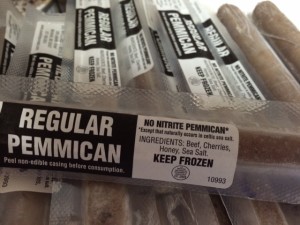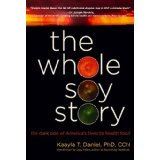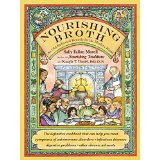
Kaayla T. Daniel PhD, CCN, The Naughty Nutritionist®, author of Nourishing Broth, was interviewed on the Anxiety Summit by host of the Anxiety Summit, Trudy Scott, Food Mood Expert and Nutritionist, author of The Antianxiety Food Solution.
Real Food for Anxiety: Butter, Broth and Beyond
- Butter and the “fats of life”
- How vegetarian diets can contribute to anxiety and other mental health disorders
- Why soy is NOT a health food and why it can contribute to anxiety, ADHD and other mental health challenges
- Paleo diet and “nose to tail eating”
- Broths help to cure melancholy/depression and help us deal with stress
- A simple broth recipe
- The component in broth that helps calm the mind and quell anxiety
- How broths heal the gut and how this heals our brains
We started with a discussion about the harmful effects of soy:
What I would say for sure is that soy has a disastrous effect on gut health. We all know now that the gut and the brain are very, very connected.
The component in the soy bean that has such a terrible effect on the gut is the trypsin inhibitor or some people would call it protease inhibitors. Trypsin or protease are the enzymes we need to digest protein properly. If we’re inhibiting that process, the fact that soy beans are high in protein is a problem because we’re inhibiting the ability to digest that protein very well. You end up with a lot of digestive distress.
Then the inability to digest the protein and the stress on the pancreas can lead to what we often see with people is pancreatitis.
That’s where you start seeing some of the anxiety problems, for example, because chronic pancreatitis is a long-term progressive inflammatory disease, and it can cause distress including anxiety
We talked about one of my favorite replacements for soy-based energy bars: pemmican. I just call pemmican the energy bar of the twenty first century. It’s just a wonderful snack to have. It’s healthy. It has good fats, and it sustains you. You can purchase pemmican from US Wellness Meats.
Then we talked about broths and glycine:
there’s a lot of different definitions of broth and stock, but basically we’re taking animal bones, and they’re going to come complete with cartilage and some skin. We’re going to make a broth with that. The main ingredients would be those bones plus a good quality water and a little bit of apple cider vinegar or a different kind of vinegar. Actually, any kind of vinegar or perhaps a wine that will help pull the collagen or the gelatin out of the bones and cartilage as well as some of the minerals.
We’re going to have a very, very delicious and rich broth. From that, we can go and make soups and stews. There’s also ways we can do things like start from the beginning with, say, lamb skanks and vegetables and make that into a dish. The point is we’re pulling all the minerals and the cartilage and the marrow from the bones into our diet in terms of a delicious broth, soup, or stew.
we have some science behind it quelling the stress and anxiety too. One of the factors would be there’s some evidence that broth will help us sleep. Now, that’s pretty interesting because broth is actually completely devoid of tryptophan and we think we need tryptophan to sleep well. We do, but broth does contain glycine and glutamine and that can help us sleep
I mentioned that I had found a large amount of research looking at a specific antibiotic called Cycloserine
it’s actually an antibiotic that is used for tuberculosis and is sold under the brand name Seromycin. They discovered that this antibiotic can actually penetrate that central nervous system via the blood brain barrier and is effective for anxiety, social anxiety, phobia, and fear of public speaking. It affects the glycine bonding sites. Wow, if we’ve got this drug that will affect the glycine binding sites, why not just incorporate more glycine into our diets in the way of beautiful broths.
Here is one of the 2015 papers: D-cycloserine augmentation of cognitive behavioral therapy for anxiety disorders: an update.
And an older one: Dose-related anxiogenic effect of glycine in the elevated plus maze and in electrodermal activity.
Here are Kaayla’s books:
The Whole Soy Story: The Dark Side of America’s Favorite Health Food
Nourishing Broth: An Old-Fashioned Remedy for the Modern World
If you are not already registered for the Anxiety Summit you can get live access to the speakers of the day here: www.theAnxietySummit.com
Missed this interview or can’t listen live? Or want this and the other great interviews for your learning library? Purchase the MP3s or MP3s + transcripts and listen when it suits you.
You can find your purchasing options here: Anxiety Summit Season 1, Anxiety Summit Season 2, and Anxiety Summit Season 3.



Are there any particular pemmikan bars that you recommend?
Hi Kal I like the ones that have salt
I like the ones that have salt
Yes! I love the ones from US Wellness Meats – see the pic and link in the blog above
Trudy
Thank you for this interview. It validated my instinct. I always felt better after eating butter. And meat. And had no desire to eat soy — or the protein bars that include it. Now I know why. I look forward to adding broth and pemmincan to my diet. Thanks so much.
Wonderful Karen – enjoy!
Join our broth-making community at nourishingbroth.com!
thank you so much for bringing the summit together Trudy, and thank you Kaayla just love the way you incorporated the Weston A. Price formation its so valuable. Lots of such useable information for everyone.
Thank you
Yvonne
Wonderful Yvonne!
New broth makers should be aware that the broth will be MUCH more appealing when strained.
So true. Thanks for pointing that out. The taste and appearance of broth greatly improves if we refrigerate the broth and skim off the fat. Straining and skimming off the scuzz is particularly important when using supermarket bones. There’s definitely less scuzz when using pastured bones.
Is there a difference between the benefits of fish broth and bone broth?
I recommend a variety of bone broths — chicken, beef, lamb, fish etc. Fish broth is also made with bones, sometimes whole little fishies as with bonito broth. The fish heads contain lots of iodine, which most people need.
Thank you for a wonderfully informative summit, Trudy.
I have a question about NON-GMO Soy. Some organic chickens I have bought are fed NON-GMO grains to fatten them up before harvest. Therefore my question is: Would you still recommend using the carcass for bone broth?
Vivienne
In an ideal world I would not recommend such chickens to eat or for broths but there are degrees of everything with pastured at the top i.e best, then pastured + fed some organic grains, then free-range + fed some organic grains, then organic-fed (best would be organic grains and not soy) and then factory farmed (to be avoided)
Trudy
It can be very hard to find eggs and meat from soy-free chickens. This is a huge problem for high allergic people. I’ve written about that topic here:
http://www.westonaprice.org/blogs/kdaniel/soy-ling-egg-yolks-hidden-soy-from-animal-feeds/
Hi, I failed to find the references to the study made where a man sought for a society that could survive with good health intact using only vegetarian model.
Also, some early philosophers were mentioned.
Could we get these names and references as promised, please?
Certainly Elizabeth
Weston A. Price is the dentist we talked about
American Journal of Psychiatry in 2008 – “Treatment of Depression by Maimonides (1138–1204): Rabbi, Physician, and Philosopher” http://ajp.psychiatryonline.org/doi/abs/10.1176/appi.ajp.2007.07101575
Dr. Weston A. Price said he searched the world for a culture in which plant foods “without the use of animal products, were capable of providing all the requirements of the body for growth and for maintenance of good health and a high state of physical efficiency.” Sadly, he reported:
“No group that was building and maintaining good bodies exclusively on plant foods” Several groups were “endeavoring to do so with marked evidence of failure.”
I write about Moses Maimonides, Hildegard von Bingen and other historical physicians, philosophers & healers who spoke of the healing powers of broth in “Nourishing Broth: An Old Fashioned Remedy for the Modern World.”
What is your opinion on using a pressure cooker to make quick cooked broth to minimize amine formation?
Hi Lisa
At one stage I used a pressure cooker but have since discovered that the high temperature is not a good idea in general. I’m not sure about broths but would assume the same applies. I’ll see if Kaayla can come and respond too
Trudy
I don’t use a pressure cooker myself — as the Naughty Nutritionist I’m sure I’m so “hot” I’d explode it all over the kitchen! Seriously, I hear a lot of stories of people making beautiful broth with pressure cookers and they say their broth gels especially well. So if that’s your preference go for it.
I just prefer a slow cooker and it’s so simple to use I don’t see any reason to switch.
Dear Trudy,
Thank you so much for this wonderful in lightening and empowering Anxiety Summit! Trudy you mentioned there are supplements that have both GABA and Glycine in them. I have both anxiety and depression caused by Hashimoto’s and Adrenal fatigue. Could you recommend a good support supplement to give me an added boost. I’m pleased to learn from Dr. Kayla Daniel that making bone broths will help the gut and brain, and really happy to know it is not as hard as I thought it would be to make them!
Starr
Glad you’re enjoying it! And yes to bone broths!
I recommend you start with the amino acid information and questionnaire before assuming you may benefit from GABA/glycine https://www.everywomanover29.com/blog/anxiety-targeted-individual-amino-acid-supplement/ The aminos are just one of many possible solutions which I’ll be covering in my final talk 65+ possible causes – so do tune in to that one. I’ll also be covering supplements
Trudy
Thank you Trudy for your prompt response! I will do the questionaire and will be looking forward to your next talk! Hoping I can find help with quieting my monkey mind. I hate to even go to sleep, as I know I will just dream excessively and wake up unrested as usual and upset with the dreams too!
Again, thank you for caring expertise which is sooo comforting!
Starr
Monkey-mind is often low serotonin so yes, do the amino questionnaire…
And now that you mention dreams read up on pyroluria and do the pyolruria questionnaire too https://www.everywomanover29.com/blog/pyroluria-social-anxiety-introversion/
Re glycine, I recommend real food in the form of lots of bone broth — 3 cups a day if you are facing health challenges. Many people following paleo-style diets eat a lot of muscle meats, which creates imbalances. Mother Nature meant us to do “nose to tail eating” and that means not just steaks and chops but organ meats such as liver and carcass, bones, marrow as consumed as broth.
Alternatively, consider high quality bovine tracheal cartilage. I’ll soon have a high quality product coming out from Vital Proteins. Until then, email me and I can help. wholenutritionist@earthlink.net
Bone Broth
I have a class 0/I Equivocal/Low IGE allergy to chicken. I tried to heal my gut with chicken bone broth and fish broth (couldn’t digest red mean/pork at the time). Is the chicken bone broth causing more damage than healing and should it be avoided in this scenario?
Butter
What parts of milk is butter made from (and also ghee) and should it be consumed if: class 0/1 IGE allergy to Alpha Lactalbumin (Casin is fine) and IgG and IgA “out of range” food sensitivity to casein (alpha&beta) and whey protein.
Thank you!
Chicken bone broth is not required. Broth greatly improves the digestibility of food, and many people find they can digest long-cooked tender meats found in soups and stews. Could you tolerate turkey, lamb, beef or fish broths? Any and all could help with your healing.
The convenience of crock pots is great but what is Kaayla’s position on lead leaching from most all crock pots/ceramic glaze? And leaching from animal bones (even if you know the source/farmer) posted on your blog Trudy?
My lead has gone up since eating pastured meat/broths – of course lead could be from many sources but definitely a concern.
I address the bone broth/lead issue in this blog here:
http://nourishingbroth.com/articles/lead-in-bone-broth-no-worry/
Is your lead actually going up or are you getting healthy enough so you are finally eliminating deep pockets of it? Lead often stays “hidden” in hair tests until other metals such as aluminum and mercury have come up and out.
I would definitely like to do some testing of all the major brands of slow cookers for lead and other potential toxicity issues. Anyone want to help fund that?
I often reuse bones to make broth. Last night I made broth using the crock pot for the first time. (Great suggestion!) I had to use the cleaver to get all of the turkey carcass to fit into my crock pot. This is so much easier than the stock pot method. THANK YOU! I’m going to have to try the uncooked chicken + feet soon.
Hi, my question was taken down for some reason. I think it was from the lecture about “just the fats” that an old quote came up about butter in the morning, butter in the evening and living to 102. I am trying to share it with a friend. I’m pretty sure it was during your lecture, but if not would you be so kind as to email me and let me know. Thanks, so much.
I loved your lecture!
Joanne
Joanne
This is what Kaayla said…There was even an old Dutch proverb that holds, “Eat butter first and eat it last, and live until 100 years be passed.”
re: the trypsin in soybeans rendering it dangerous for human consumption?
take home: cook those soybeans.
“Thermal inactivation of trypsin inhibitors of soybean preparations added to meat.”
Kozlowska H, Elkowicz K, Rutkowski A.
Meat Sci. 1980 Apr;4(2):95-102
The activity of trypsin inhibitors was investigated in minced meat in which 30% of meat protein was replaced by soybean preparations (flakes, concentrate, isolate, textured flour). Trypsin inhibitors were determined in 20% suspensions of these soybean preparations. The activity of trypsin inhibitors in soybean preparations added to meat, or suspended in water, appeared to be higher than that of dry products. The heat treatment (70, 80, 90 and 100°C for 15 min) reduced the inhibitor activity in all soybean preparations, both in model meat systems (MMS) and in suspensions. Trypsin inhibitor activity was higher in MMS than in water suspensions of soybean preparations, suggesting that meat components protect trypsin inhibitor proteins against heat treatment. Trypsin inhibitor activity in heated meat model systems was too low to produce unfavourable nutritional effects.